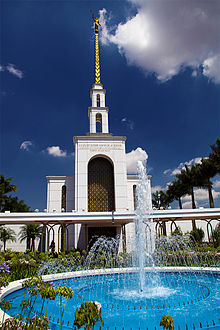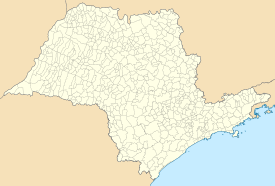| São Paulo Brazil Temple | ||||
|---|---|---|---|---|
 | ||||
| Number | 17 | |||
| Dedication | October 30, 1978, by Spencer W. Kimball | |||
| Site | 1.85 acres (0.75 ha) | |||
| Floor area | 59,246 sq ft (5,504.1 m) | |||
| Official website • News & images | ||||
| Church chronology | ||||
| ||||
| Additional information | ||||
| Announced | 1 March 1975, by Spencer W. Kimball | |||
| Groundbreaking | 20 March 1976, by James E. Faust | |||
| Open house | 17 January – 14 February 2004 (after renovations) | |||
| Rededicated | 22 February 2004, by Gordon B. Hinckley | |||
| Designed by | Emil B. Fetzer | |||
| Location | São Paulo, Brazil | |||
| Geographic coordinates | 23°35′06″S 46°43′22″W / 23.5851°S 46.7227°W / -23.5851; -46.7227 | |||
| Exterior finish | Cast stone composed of quartz and marble aggregates set in white cement | |||
| Temple design | Spanish influenced modern, single-spire design | |||
| Baptistries | 1 | |||
| Ordinance rooms | 2 (Movie, stationary) | |||
| Sealing rooms | 4 | |||
| Clothing rental | yes | |||
| (edit) | ||||
The São Paulo Brazil Temple (formerly the São Paulo Temple) is the 19th constructed and 17th operating temple of the Church of Jesus Christ of Latter-day Saints (LDS Church). Located in the Brazilian city of São Paulo, it was the first Latter-day Saint temple built in South America, and the first to use a single story, single spire design. The spire is 101 feet (31 m) tall. The intent to build the temple was announced on March 1, 1975, by church president Spencer W. Kimball at an area conference. A groundbreaking ceremony, to signify the beginning of construction, was held on March 20, 1976, conducted by James E. Faust.
History
See also: The Church of Jesus Christ of Latter-day Saints in BrazilThe LDS Church in Brazil
There have been church members in Brazil since 1913, when German immigrants and church members, Max and Amalie Zapf, immigrated to the country. Several more church members immigrated to Brazil in the 1920s, but the church's first missionaries weren’t sent until 1928, with the first converts baptized in 1929. In 1930, the first branch was established. The church continued to grow in Brazil, reaching 3.700 members by the end of the 1950s. As of 2012, the church had over a million members in Brazil, and Brazil has the “third-largest Church population in the world, after the United States and Mexico.”
The São Paulo Temple
The intention to construct a temple in São Paulo was announced by the LDS Church on March 1, 1975, with construction beginning twelve months later. The groundbreaking ceremony took place on March 20, 1976, marking the commencement of construction. This ceremony was presided over by James E. Faust and attended by local church members and community leaders. Hundreds of local church members gathered to clear the site, which included removing brush, weeds, and banana trees. Hundreds more members donated their time to produce fifty thousand blocks of cast stone composed of quartz, marble chips, and white concrete for the exterior of the temple. It was dedicated on October 30, 1978, by church president Spencer W. Kimball. The temple has two ordinance rooms and four sealing rooms, and has a total floor area of 59,246 square feet (5,504 m).
On August 20, 2003, a gold-leafed statue of the angel Moroni was added to the temple during an extensive renovation and enlargement project 25 years after its dedication. Church president Gordon B. Hinckley rededicated the temple on February 22, 2004.
In 2020, like all the church's temples, the São Paulo Brazil Temple was closed temporarily during the year in response to the COVID-19 pandemic.
Design and architecture
The building has Spanish-influenced modern design, coupled with a traditional Latter-day Saint temple design. Designed by Emil B. Fetzer, the temple's architecture reflects both the cultural heritage of the region and the spiritual significance to the church.
Site
The temple sits on a 1.85-acre plot, and the landscaping around the temple features flowerbeds and a water fountain. These elements provide a tranquil setting that enhances the sacred atmosphere of the site. There is also a visitors' center on the temple grounds.
Exterior
The structure stands 101 feet tall, constructed with reinforced concrete faced with quartz and marble aggregates. The exterior is characterized by a single attached end spire with an angel Moroni statue, elements which were each chosen for their symbolic significance and alignment with temple traditions. The design uses elements that reflect both the local culture and the broader church symbolism.
Interior
The temple includes a baptistry, two ordinance rooms, four sealing rooms, and a celestial room, each arranged for ceremonial use. Symbolic elements are integrated into the design, providing deeper meaning to the temple's function and aesthetics.
Symbols
Incorporated into the design are symbolic elements representing Latter-day Saint symbolism, which provide deeper spiritual meaning to the temple's appearance and function. Symbolism is important to church members. Church members believe temples function as literal houses of the Lord, and symbolize the relationship between him and his followers.
Renovations
Over the years, the temple has undergone several renovations to preserve its structural integrity, update facilities, and enhance its spiritual and aesthetic appeal. The most significant renovation project commenced in 2002.
The renovations included expanding the temple, updating the mechanical systems, and adding a statue of the Angel Moroni to the spire. These changes were made to ensure the temple's compliance with contemporary building standards and to accommodate the evolving needs of the church and its members.
The renovation included refurbishment of the original furniture, which was made in the factory of Walter Spat, who was the first president of the first stake in Brazil. The furniture “remains in excellent condition because of the high quality of the original work.” This highlights the care taken to maintain the original design of the temple.
The renovated temple was rededicated on February 22, 2004, by Gordon B. Hinckley.
Cultural and community impact
The temple and its surrounding grounds hosted a cultural celebration on February 21, 2004, to commemorate the temple’s rededication. Despite torrential rain, approximately 60,000 people gathered in Pacaembu Stadium for the event. The celebration featured dancers in traditional costumes, characters from Brazilian children’s literature, and a 1,200-person choir.
The visitors' center helps educate and spiritually uplift the community by providing insights into the history of the church in Brazil. The visitors' center was dedicated on January 21, 2019, and was the first visitors’ center in South America. It is equipped with a Christus statue and interactive exhibits. The visitors’ center provides members and non-members with understanding of “the love of the Brazilian people for one another and for the Savior” and the temple's unique place in church history.
Temple presidents
The church's temples are directed by a temple president and matron, each serving for a term of three years. The president and matron oversee the administration of temple operations and provide guidance and training for both temple patrons and staff.
The first president of the São Paulo Brazil Temple was Finn B. Paulsen, with the matron being Sara M. Paulsen. They served from 1978 to 1979. As of 2024, Reinaldo de Souza Barreto is the president, with Glaucia R. Barreto serving as matron.
Other notable temple presidents include: Helio R. Camargo (1990–93); Athos M. Amorím (1993–96); and Jairo Mazzagardi (2006–09).
Admittance
When the temple was completed, an open house was held in September 1978. The temple was then dedicated by Spencer W. Kimball in ten sessions from October 30-November 2, 1978. Following the temple’s renovation period from 2002-2004, another open house was held from January 17-February 14, 2004, with around 99,000 people attending. The temple was then rededicated on February 22, 2004, by Gordon B. Hinckley. Like all the church's temples, it is not used for Sunday worship services. To members of the church, temples are regarded as sacred houses of the Lord. Once dedicated, only church members with a current temple recommend can enter for worship. The visitors’ center is available to the public.
See also


 = Operating
= Operating = Under construction
= Under construction = Announced
= Announced = Temporarily Closed
= Temporarily Closed
- Comparison of temples of The Church of Jesus Christ of Latter-day Saints
- List of temples of The Church of Jesus Christ of Latter-day Saints
- List of temples of The Church of Jesus Christ of Latter-day Saints by geographic region
- Temple architecture (Latter-day Saints)
References
- ^ "São Paulo Brazil Temple". Church News. Retrieved 2024-08-20.
- "Brazil: Chronology". www.churchofjesuschrist.org. Retrieved 2024-08-20.
- Studies, Mark L. Grover Retired Professor of Latin American; University, Brigham Young. "The Church in Brazil: The Future Has Finally Arrived". www.churchofjesuschrist.org. Retrieved 2024-08-20.
- ^ "The Church of Jesus Christ of Latter-day Saints in Brazil and the Amazon Region". newsroom.churchofjesuschrist.org. 2012-04-23. Retrieved 2024-08-20.
- "Brazil Is Rising". www.churchofjesuschrist.org. Retrieved 2024-08-20.
- "São Paulo Brazil Temple". newsroom.churchofjesuschrist.org. Retrieved 2024-08-20.
- Brigham, Janet (October 1978). "The Sao Paulo Temple: Story of Sacrifice and Learning". The Ensign. Retrieved October 30, 2018.
- Berteaux, Kelsey; Rosner, Jannalee. "10 Things You Didn't Know about the Angel Moroni Statue". LDS Living. Retrieved October 30, 2018.
- Assis, Fernando (January 30, 2004). "Sao Paulo temple ready for re-dedication". The Church News. Retrieved October 30, 2018.
- Stack, Peggy Fletcher. "All Latter-day Saint temples to close due to coronavirus", The Salt Lake Tribune, 26 March 2020. Retrieved on 28 March 2020.
- ^ "Sao Paulo Brazil Temple". Church News. 2024-01-11. Retrieved 2024-08-21.
- ^ "São Paulo Brazil Temple | ChurchofJesusChristTemples.org". Temples of The Church of Jesus Christ of Latter-day Saints. Retrieved 2024-08-20.
- "São Paulo Brazil Temple". www.churchofjesuschrist.org. Retrieved 2024-08-21.
- "SAO PAULO BRAZIL TEMPLE: 'We are grateful for the faithful Saints'". Church News. 2024-01-11. Retrieved 2024-08-21.
- "Why Latter-day Saints Build Temples". www.churchofjesuschrist.org. Retrieved 2024-08-21.
- ^ "Sao Paulo temple ready for re-dedication". Church News. 2024-01-11. Retrieved 2024-08-21.
- "São Paulo Brazil Temple". newsroom.churchofjesuschrist.org. Retrieved 2024-08-21.
- "Brazilian pageantry". Church News. 2024-01-11. Retrieved 2024-08-21.
- ^ "Look inside the first visitors' center in South America". Church News. 2024-01-11. Retrieved 2024-08-21.
- ^ "Presidents and Matrons of the São Paulo Brazil Temple". Temples of The Church of Jesus Christ of Latter-day Saints. Retrieved 2024-08-21.
- "Inside Temples". www.churchofjesuschrist.org. Retrieved 2024-08-21.
External links
 Media related to São Paulo Brazil Temple at Wikimedia Commons
Media related to São Paulo Brazil Temple at Wikimedia Commons- São Paulo Brazil Temple Official site
- São Paulo Brazil Temple at ChurchofJesusChristTemples.org
| The Church of Jesus Christ of Latter-day Saints in South America | |||||||||||||||||
|---|---|---|---|---|---|---|---|---|---|---|---|---|---|---|---|---|---|
| Countries |  | ||||||||||||||||
| Temples |
| ||||||||||||||||
This article about a Brazilian religious building or structure is a stub. You can help Misplaced Pages by expanding it. |